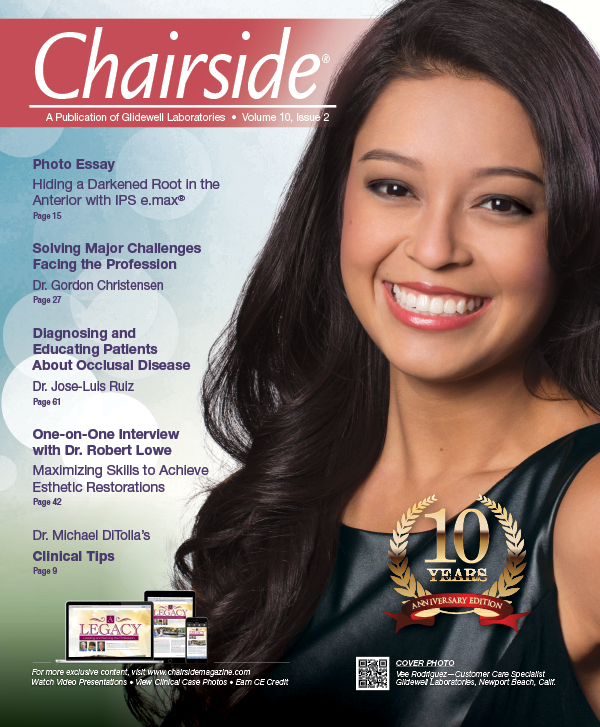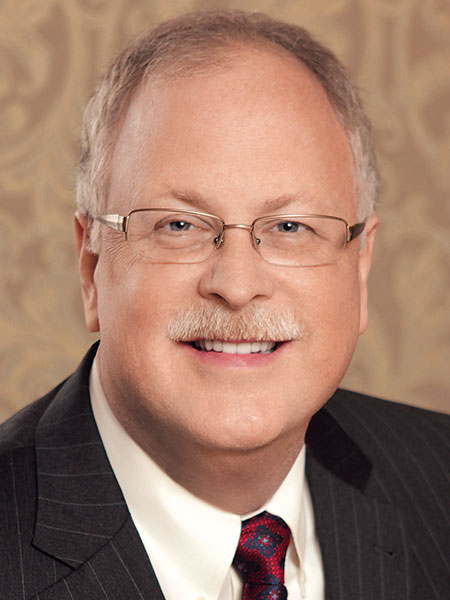One-on-One with Dr. Michael DiTolla: Interview with Dr. Bob Lowe
Dr. Bob Lowe, a restorative dentist from Charlotte, North Carolina, has been a clinical mentor to me for many years. After admiring his work from afar and reading about him in dental journals, I finally had the chance to attend one of his courses. I came out of that course with a fresh new skill in hard- and soft-tissue crown lengthening. I’ve adopted several of his techniques into my skill-set and hope you can learn from him as well.
Dr. Michael DiTolla: Well, welcome to the latest interview in our series. Today, we have one of my clinical mentors going back a long, long time. Well, not that long, but long enough. A little longer than I’ve been practicing, and Bob is one of the first names that I’ve recognized to win the Gordon Christensen Outstanding Lecturer Award. I’ve always been fascinated by Bob’s ability to do myriad things well. The old saying is, someone who is a jack of all trades is typically a master of none, and I think Bob might be the exception to that because he can do a lot of different things well, from restorative, to surgical, to you-name-it. We’ll find out what else he can do as we get into this interview. Bob, thank you so much for taking some time out of your schedule to speak with us.
Dr. Robert Lowe: I appreciate the opportunity, Mike. I know we’ve been trying to put this together for a while and, scheduling permitting, we were finally able to hit that magic day and time. It’s good to be here.
MD: Well, I know you do a lot of lecturing as well. I know you do more than me. Any idea how many dates you did in 2014, for example?
RL: I probably average about 25 to 30. But who’s counting, you know? I try not to look too far ahead because as you get older, the more stuff you cram in, the more it falls out. So I just try to look at the next week and try to know I’m going to the right place.
MD: Exactly. Make sure you step on the right American Airlines flight. Make sure you get to the right city. What year did you graduate from dental school?
RL: Let’s see, it’s been a while; 1982, a wonderful year for Loyola University in Chicago.
MD: Is that school still there?
RL: No, we are persona non grata. What’s that famous book? “The Man Without a Country.” I’m a man without an alma mater dental school. Loyola closed in 1993.
MD: Wow, so there’s no alumni association bothering you for donations. That must be awful.
RL: It’s terrible, you know. I had planned to be such a huge contributor because we really did get a nice education. I think for a lot of people, at least in the early days after closure, they’d give money to anything before they went back to the dental school. There were a lot of bitter feelings there. It’s been a long time, but there are still a lot of hurt feelings over that.
MD: I can only imagine. When you got out of school, what was the first real part of dentistry that you felt yourself drawn to? Was there anything that you jumped on early and that became an interest of yours fairly soon after graduating?
RL: I had something that I actually jumped on early and became very interested in while I was still in pre-clinical. Many people out there still remember a fantastic artistic clinician named Dr. Harold Shavell. Harold came to our dental school in the spring of 1980 to do an all-day lecture for a special program we had every spring called “Honors Day”; the restorative chairman would bring an outside speaker in so we could hear something that was a little bit less, you know, skewed than the normal Loyola tale. He brought Harold in, and he showed with his three projections, three screens, some of the most beautiful carved amalgams. Michelangelo couldn’t have done a better job. And I’m sitting out there as a sophomore dental student looking up at that thinking, number one: They’re not teaching us that. And number two: That’s what I want to do when I grow up. It was more of an inspiration right out of the gate, even before I saw my first patient.
MD: And you were the one who turned me on to Dr. Shavell and his articles and his interests. He’s an amazing guy. I remember an article that he wrote on amalgam, it was so poetic and stood out because you just don’t see writing like that typically in dentistry. It’s usually very clinical and very dry, and this was almost a romantic type of writing about these procedures.
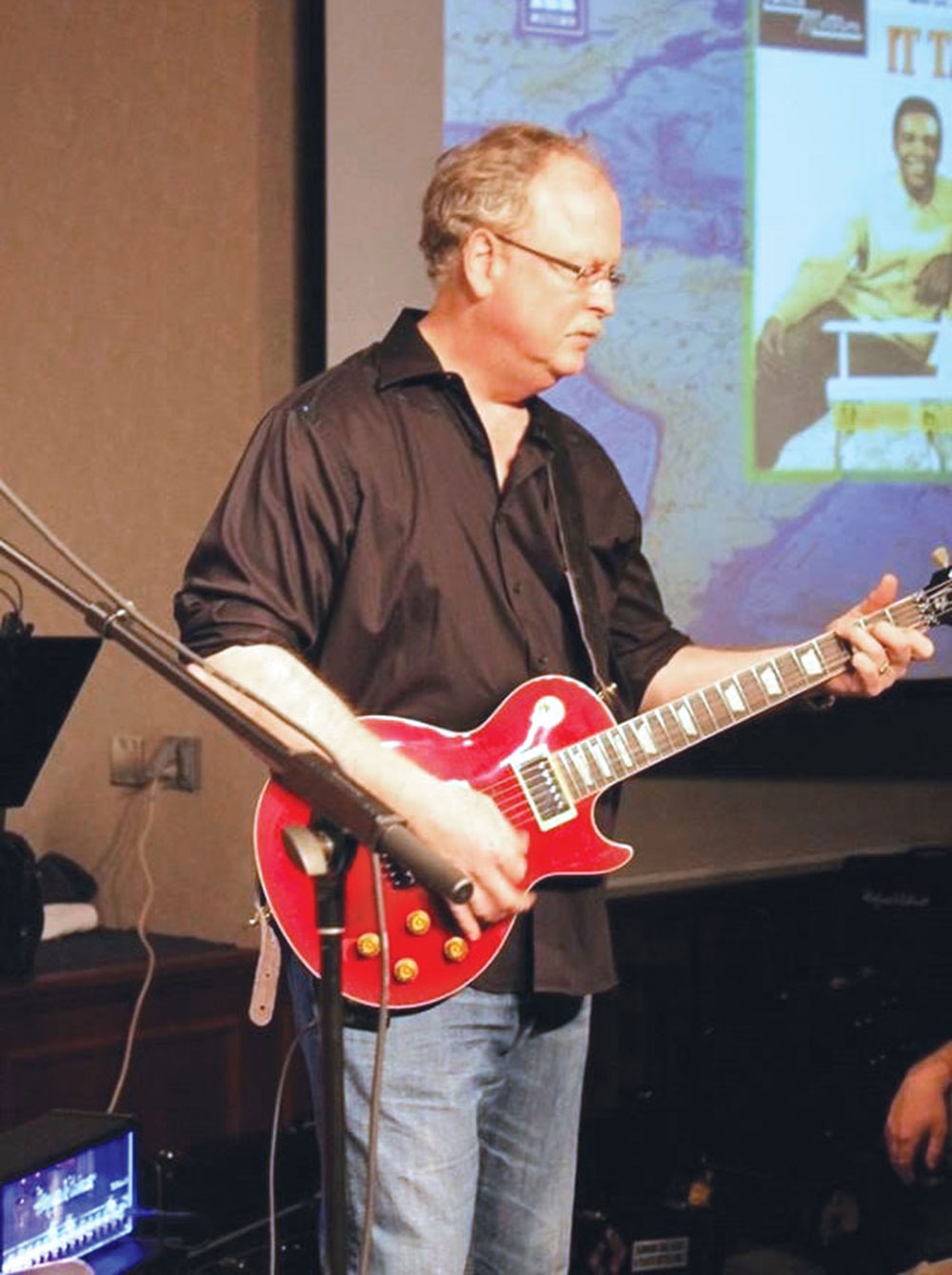
RL: “Romancing the Beautiful Silver Maiden: An Allegorical Love Story.” That was the name of the article. There isn’t anybody who has ever written like that or probably will ever again. It was poetry, and it was meant to be mental imagery. That’s what he always taught: You should be able to close your eyes and see these images of the occlusal surfaces on the backs of your eyelids. And he would say, “If you can draw it, you can carve it.” And, “The eye doesn’t see what the mind hasn’t taught it to recognize.” It started early on with those types of inspirations. And then taking those and putting your own spin on that. Having your failures and picking yourself up and dusting yourself off, and trying again time after time. That’s really what led me down my path.
MD: Once you mentioned Dr. Shavell to me, I went back and started looking for some of his older articles, and they’re difficult to find because these were published a while ago. You can find some of these articles through PubMed and Google Scholar. I really dove into what he was doing and his meticulous nature, and his absolute dedication to making sure that the tissue was as perfect as possible. I mean, he was the guy who got me to not impress cases on the prep date, and make sure that you see how the tissue reacts to the provisionals before you even think about going in and impressioning it. He indirectly, through you, left such a mark on me that I would mention him at every lecture. I don’t remember where the lecture was, but I was giving a lecture and I was talking about him and his ideals and what an impression he had left on me, and at the break, his wife came up to me and said: “He’s here. He’s here at your lecture.” And I said: “Oh my God, I have to meet him. Where is he?” She said, “He’s in the restroom.” And I said, “I can wait.” She came up and made sure that we got a chance to meet and talk for about 10 minutes during the break. It was one of the bigger thrills of my life, and it was because you had introduced me to his work. It really is a very high standard, and it was one of the things that taught me that the one thing you really need to do for great dentistry, almost more than anything else, is to have patience. There’s just not much room to rush a lot of this stuff and still have it turn out great.
RL: Plus, having someone like that set the bar. In being so close to him and hearing him speak for so many years and listening to others relay their stories about him, I think it’s important for us, as dentists in our field, that we have people who raise the bar. It inspires us to reach as high and as far as we can on our own to attempt to achieve that. I’m still reaching. That’s what excites you every day — that’s what excites you about the next case. I’d always ask him over the course of his time — he’s been retired from clinical practice now for almost 15 years — I’d always ask him, “What’s your favorite case out of all the cases that you’ve done?” And he would show some amazing full-mouth rehabilitations at 10, 15, 20, 25 years. Spot-on occlusion. “What’s your favorite case?” And his answer is always the same: “The next one. The next one will be my favorite case.” And that’s the way he was.
MD: So were you instantly drawn to crown & bridge? Because a lot of the things I saw Dr. Shavell write about were around crown & bridge. Did you find yourself kind of drawn to esthetics first, or where did you find some of your bigger challenges in those first few years?
RL: Well, I grew up at a very interesting time — like you — in dentistry. I mean, in the mid-’80s, when we were in dental school and just getting out of school, the esthetic revolution was just taking off. We just learned how to bond tooth-colored material to enamel and then to dentin. So we have tools now that Dr. Shavell never had. His main thing was either alloy or crown & bridge. And now we can glue a little puzzle piece of ceramic to a part of a tooth and make it whole again and have it disappear. It’s a different world. The thing he always said was: “The rules don’t change. It doesn’t matter if it’s one tooth or 28, you still have to follow the rules.” And that’s one thing that was really a dichotomy to me in dental school, because we went to crown & bridge, and we learned morphology and wax-ups and the Peter K. Thomas technique. And we learned occlusion by putting these wax-ups on chewing simulators we called articulators. We’d dust them off with powder to see the contact points and follow the excursions and the disclusion and all this stuff. Then we’d go to operative, and we’d have a hole in the middle of the tooth and plunk a piece of lead into it, put the sign of the cross on it and call it a day. I mean, it just was a total disconnect. That’s one thing that Dr. Shavell really helped to open my eyes to, and I’m sure he did the same for a lot of other people. It doesn’t matter whether the material is yellow, silver, tooth-colored or whatever. An occlusal surface of a tooth is meant to look the way that nature intended. Whether you’re restoring a single tooth in an arch, an entire arch or an entire mouth, the rules are the same.

MD: That’s funny because practicing in a laboratory, especially a bigger one like ours that has a variety of different technicians, one of the things that dentists used to complain about was the variety in contour, shape and anatomy from one crown to the next; from one technician to the next. It’s funny how CAD/CAM is really becoming a saving grace in that respect, where we now have some idealized anatomy. If the doctor gives us enough room, there’s a pretty good chance that one crown to the next crown to the next crown is going to look the same, especially when they’re being made by mills as opposed to being handmade by technicians. One of the effects it’s having is stamping the artistry out of the dental laboratory, at least in the posterior — not so much in the anterior. Tell me a little bit about your experience with CAD/CAM and how you’re using it to your advantage.
RL: Well, at this point in my career, I’m just scratching the surface there at least on the CAD/CAM part. I mean, I’ve been doing digital impression making for years with iTero™ (Align Technology, Inc.; San Jose, Calif.), and having the models made from a digital scan and having the technician do the restoration from the model. Now, that doesn’t mean that those technicians are taking those models and building the restoration by hand, though. They could be scanning those models and milling those restorations in the laboratory, which I’m sure they are. As a matter of fact, I was out in Scottsdale, Arizona, and my former dental hygienist, who was a treatment coordinator in our practice here in Charlotte in the early 2000s, now is the CEREC® specialist for Sirona Dental Systems, Inc. (Charlotte, N.C.) in that territory. Greta had been after me for a long time to jump on that bandwagon. I think we’re getting to the point where, whether it’s chairside- or lab-milled, the restorations are fitting better and looking better. I have one in my mouth. One of my students from Loyola who practices in Charlotte, Dr. Tom Farley, offered for us, the doctor, to get our treatment time in. We’re there to fix everybody else, and we’re always last in line. So I went to Tom’s office, and he did a chairside milling of a second molar for me. And it’s doing fine. I think that’s where we’re going for posteriors for sure. I don’t think we’ll ever take all the artistry out of anteriors. But then again, I’ve never been the idealist for finding absolute perfection in the anterior, in any way, shape or form. You know, the guy who talks about a little drop of spit on some slide that has a beautifully gorgeous clinical result. Beauty is indeed in the eye of the beholder. Not everyone appreciates the quality of a Maserati; some people actually like to drive Yugos. To try to fit that kind of perfection into every patient and every practice? I think that’s unrealistic. I think you’ve got to have options for patients. The CAD/CAM-milled restorations, even in anteriors, are starting to look better. The zirconia materials are starting to look better. I think the sky is the limit. It’s definitely here to stay and be part of what all of us will be doing. Whether we’re doing it chairside or with a lab, it’s going to be with us into the future.
CAD/CAM-milled restorations, even in anteriors, are starting to look better. The zirconia materials are starting to look better. I think the sky is the limit.
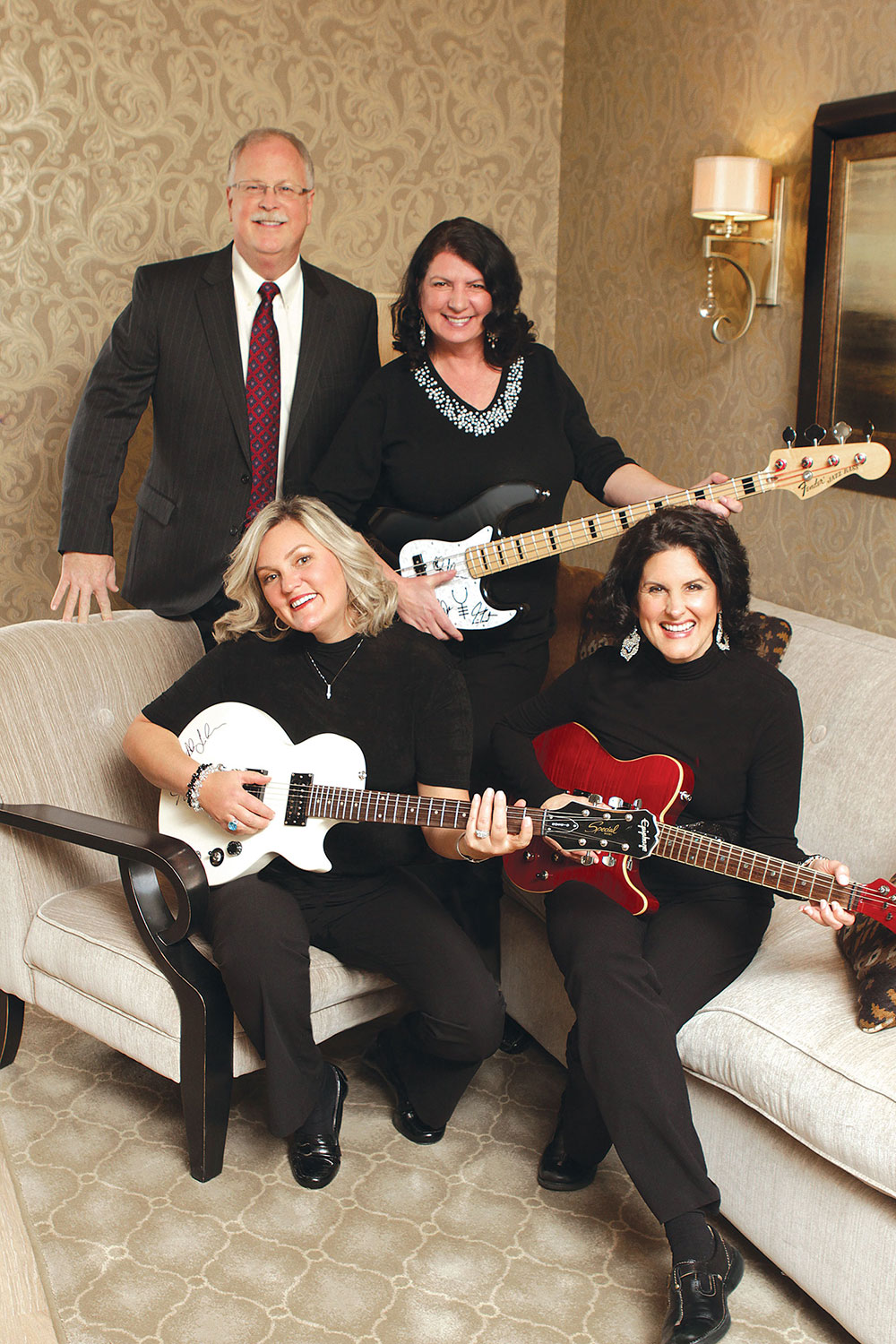
MD: Were you actually out there taking a class on getting involved with CEREC? Was that what you were doing in Scottsdale?
RL: I took the CEREC Connect class. I wanted to go out there and learn a little bit about the machine and how to use the technology. I remember seeing CEREC 2 and CEREC 3; you had to have an engineering degree to follow the little ball on the tangent. They would say, “After you do about 300 of them you’ll get the hang of it.” At that point in time it wasn’t really something I was on board with.
MD: You’re one of the guys I can picture staining and glazing an anterior crown and getting a decent result. Is that not something that excites you?
RL: Yeah, it does in one way, but I’ll tell you, in another way, the whole stain and glaze thing and surface modification is great, as long as the occlusion is good. If you have to adjust it after that? Forget it.
MD: Well, not only that, but even on anterior restorations, Gordon and I are always having discussions about how long the surface stain on an anterior tooth is going to last with all the acidic foods and drinks that people have. Will it be there in five years? Will it be there in seven? There’s something to be said for cut-back and layer and three-dimensional color. Or, gosh, even with a feldspathic veneer.
RL: Right, and that’s why I think good laboratory technicians don’t have anything to worry about. I mean, there are going to be people who have the demand for high-quality esthetics. And I think that just goes back to the old tried-and-true, whether it’s layering on a milled coping or stacking it from the ground up. In the back teeth, you know, they go through a lot of issues with traumatic occlusion. I mean, everybody doesn’t have that perfect ideal occlusion that Shavell taught us about. He used to say that chewing is a self-destructive act. So, we do see a lot of destruction, not only of our own work but also of nature’s and God’s work as well. I mean, things don’t last a lifetime. The good news is that we can fix it.
MD: Exactly. So is that an IPS e.max® (Ivoclar Vivadent; Amherst, N.Y.) restoration that you have on your second molar, then?
RL: Yes, it’s e.max. It’s a full crown. There was an amalgam that broke because I lost anterior guidance years ago. I had a reconstruction about 12 years ago to restore my anterior guidance, so I wouldn’t break more back teeth. The result was a root canal, a crown lengthening, a buildup, a post and an e.max crown.
MD: Wow. Now, let me ask you this: If solid zirconia had been available in a chairside system at that time, do you think you would’ve gone with solid zirconia, or would you have gone with e.max for that tooth?
RL: Well, I tell you, I remember when the whole thing with Glidewell Laboratories and BruxZir® Solid Zirconia started hitting the market. Zirconia, I think, is another one of those materials that will continue to evolve both esthetically and functionally. What a lot of dentists don’t understand is that a zirconia is not a zirconia is not a zirconia. We want something that is going to withstand occlusal forces and last. Zirconia is a strong material. In fact, I was just on a conference call with Brant Miles from SS White today and he’s been talking to a lot of the bur people. We need to find a bur that’s better than what they’ve got so that when it’s time to replace the zirconia, you get the darn thing off. I think for sure in today’s world with the prices of precious metals and gold going on the way out, that zirconia is definitely something. It’s easily fabricated, it’s low-cost and, with the esthetics improving all the time, it’s a No. 1 choice for restoring posterior teeth.
MD: I’m sure the guy who did it on you reduced enough and bonded it into place, so with that type of approach e.max will work very well in the posterior. But for a lot of dentists who aren’t able to reduce as much or can’t in certain situations, the zirconia does well. We’re testing a new bur at CR that’s showing some real promise with cutting through zirconia a lot faster than the other ones. Unfortunately, you’re right. The zirconia crowns were developed two years before the first burs started coming out. There wasn’t much thought put into that. It should’ve been the reverse order, with the burs first and then the crowns.
RL: As you talk about the space, it’s a funny thing. Like I said, I was out at Scottsdale and they told me to bring a couple of cases. So I brought a couple of cases that I had scanned through iTero and had milled restorations made in the lab. One was a second molar. Because of the lack of space and the ability to reduce, because of the short clinical crowns, that was one reason why I chose zirconia for that restoration from the lab. Now, with the CEREC we couldn’t mill a zirconia, so we milled an e.max and you’ve got to set the tolerances for 1–1.5 mm of thickness. Well, when it milled my crown it had a nice hole in it. That’s one of the advantages of zirconia: If you don’t have the space, you can go down to six-tenths and still be OK with the strength. It’s definitely something that should be in everybody’s treatment plan. Because you can’t crown lengthen everything, and you can’t always reduce to create the ideal 1.5–2 mm in the posterior, which is really what you need for other materials.
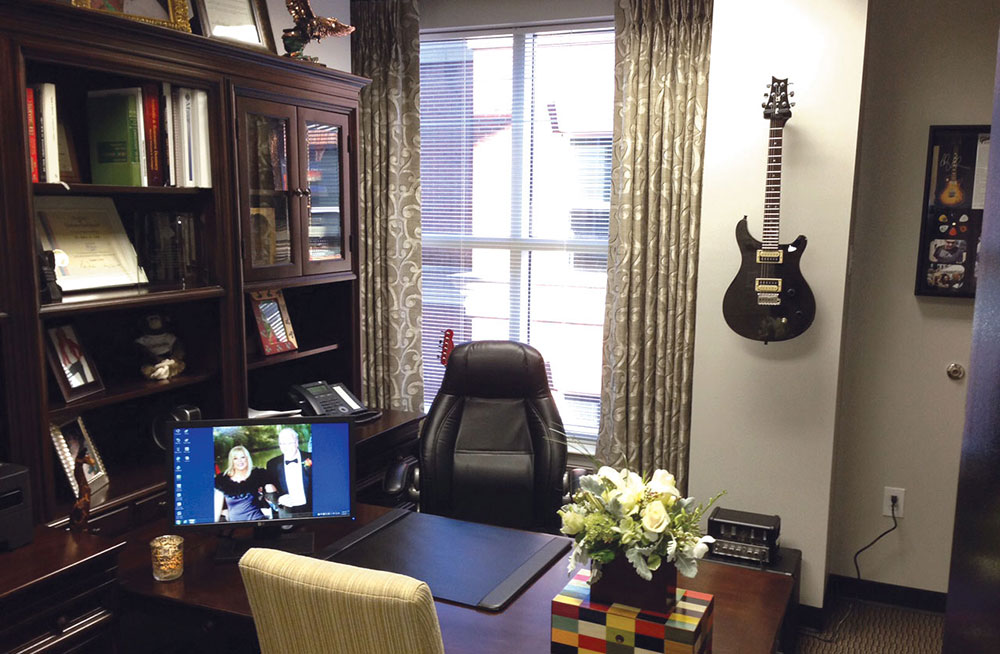
MD: And you can’t always extract the opposing tooth to make extra room.
RL: No, most patients won’t go for that.
MD: Spending time with Gordon, you know, he still says, “American dentists are pathetic in their lack of the number of GPs who are placing implants surgically, compared to European countries.” GPs in the U.S. are willing to restore them, but he thinks more of the easy implants should be done by GPs instead of specialists. I’ve seen you do crazy surgical procedures. You’re the one who taught me how to do soft- and hard-tissue crown lengthening for situations where you have altered paths of eruption. I’m wondering, are you placing many implants surgically yourself?
RL: Michael, I’m going to be honest with you, I haven’t done it. It’s not because I don’t feel that I could; I’ve done so much surgery over my lifetime that I feel totally confident in being able to do that. It’s just that my life is too busy to go out and get proficient right now. But I’m trying to set aside some time. I have a good friend who is a former dental student of mine in Chicago, Dr. Joe Favia, who trains for CAMLOG. He’s saying: “Just bring a patient. I’ll show you how to do it; it’s so easy.” And I know I’m going to do it. I’m going to take him up on his offer. In the world with CAD/CAM now, cone-beam scanning, and where you can plan the case, place the implant with a surgical stent that you cut in your own office, and do all that, there’s getting to be no reason not to get the technology and make it a go. It’s definitely on my bucket list. I definitely plan at least being able to. Maybe I won’t step out to the edge of the cliff, but you know, do one in a non-esthetic area. Why not?
MD: Why not! You mentioned digital impressions a little bit earlier. Tell me a little bit about the system that you have, and how often are you using it? I know you still probably haven’t gotten rid of all the polyether and polyvinyl from your office. Tell me a little bit about how that all fits into your practice.
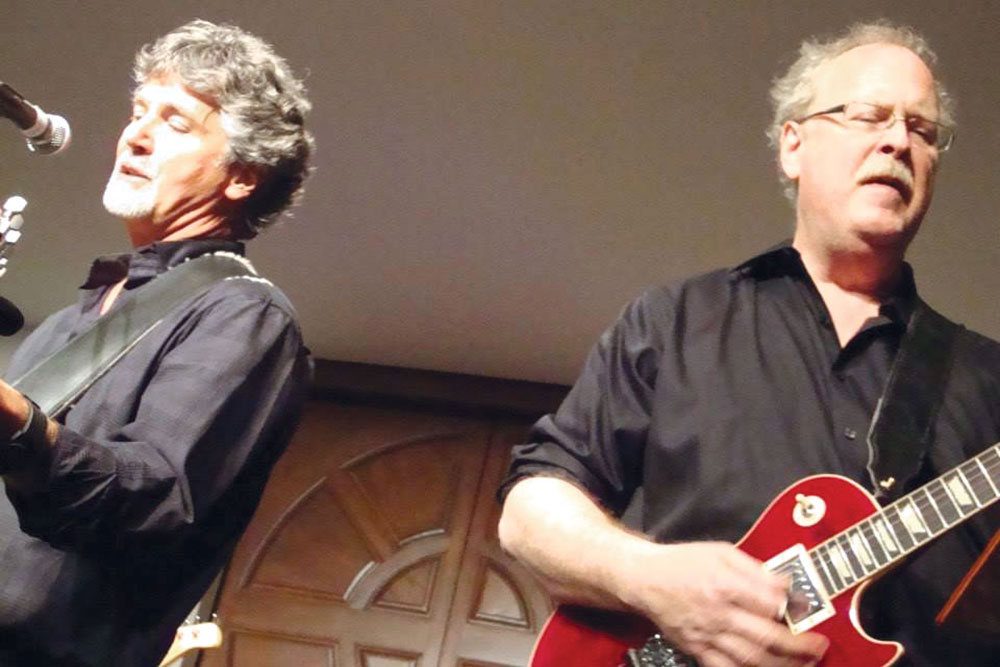
RL: I have Cadent iTero, and I’ve had it in my office for over a decade. There are a lot of scanners coming out on the market. We could sit and do a whole interview on impressions. Bringing up Gordon, I remember sitting next to him at the Chicago Midwinter Meeting a few years ago, and 3Shape (Warren, N.J.) was bringing their TRIOS® scanner in and showing it to a group of us. And I just leaned over and said: “Dr. Christensen, it’s nice to see you again. I just want to let you know that I always use a quote that you said or wrote, saying 70% of the impressions in the laboratories in our country are clinically unacceptable.” And he said, “You know, Bob, it’s really about 90%.” Which is funny because a lot of times I’ll be out lecturing and talk about the importance of preparation technique and impression making, and you’ll get comments back from the audience asking why I’m wasting time on that, and that they know how to do that already. Scary. All that being said, I think that digital technology will help raise the level of the average impression going to the lab, hands down. Now, you still have to do tissue management. The camera can’t take a picture through blood, saliva and tissue. But if you manage the tissue properly, it takes a lot of the error out. I’m convinced that a lot of that error is also translated to the model. For years, I feel like I’ve taken good impressions, and does everything just drop in? No. It doesn’t. I mean, I have days where things don’t work either. When you think about it, is the guy in the lab measuring the powder and liquid with the scale and the graduated cylinder like we did in school? Are they vacuum mixing? Or are they just putting some powder in the rubber bowl and running the water in it and slathering it around until it looks right? There’s so many possibilities for error in our indirect technique that digital takes out. The fact that the model isn’t made out of material that can expand and contract or be affected by those techniques, we can only help but get a better fit. I just think that scanners are really coming into their own. And when the price gets down to where the average dentist feels they can pull the trigger, they’ll be even more widely used. As far as the polyether and polyvinyl siloxanes? With my system, the iTero, we don’t have video streaming like TRIOS or some of the other ones. You have to take so many little clicks and pictures. If I’m doing a full-arch impression, I can still move the syringe faster than the clicks of the camera. But I know that’s because of the limitations of my system. So things are to the point where, if you want to, you can not use traditional impression materials anymore and improve overall quality.
I think that digital technology will help raise the level of the average impression going to the lab, hands down.
MD: Yeah, there’s certainly teeth where you’re replacing a crown that somebody else has already put into place that’s got sub gingival margins. You’re probably going to need polyvinyl or polyether for that — unless you’re doing crown lengthening. Another source of error that I see referenced in the literature all the time is doctors pulling impressions too early before they’ve completely cured in the mouth, and that’s a big source of distortion. In fact, some of the research is even questioning the manufacturers’ recommended times as being too early, and if you leave these in for six, six-and-a-half minutes, it can go through its setting reaction.
RL: That’s because the industry has been asking for faster and faster products. I really don’t care if the impression material sets up in one minute and thirty or three minutes and thirty. I mean, my rule of thumb has always been: Whatever the manufacturer says, add at least a minute. Why are we in such a hurry?
MD: It’s hard to say why. Even though we measure, and we have an auto batcher that mixes all of our die stone for us and it’s actually in the correct measurements, it expands a certain amount just based on averages for how much impression materials shrink. We don’t really know what impression material a doctor is using, so it’s still kind of a guesstimate.
RL: And how about the triple trays that have no vertical supports so that the impression materials can bend with the influence of the stone? I mean, there are so many different factors where potential error can come in that it still amazes me that despite all those factors, we can still have a laboratory restoration fabricated that fits to within the 50 microns as much as we do. There’s a lot of chance for error, from the lack of reduction right on down to poor impression to inaccurate mounting and model work to everything on the other end.
MD: And I’m convinced that there’s no better bite registration than the patient biting together with nothing in between their teeth, and then shooting a buccal bite. That said, with all that accuracy you can flush it all down the toilet if the temporary is no good or if it’s slightly out of occlusion.
RL: The thing I always tell people is, I look at occlusion and stability like a three-legged stool: one missing piece, and it won’t work. I never would use an occlusal registration material and shoot a horseshoe around the entire arch, because you’ve essentially replaced the missing leg. So if I’ve got #8 and #9 prepped, I’ll put a little bite registration over the #8 and #9 prep area and leave the rest of it cleared so the technician can visually see that the occlusion socked in everywhere else. You’re absolutely right, because when you can’t see where the patient is biting, you don’t know whether or not the bite is correct or not.
MD: All we want in the laboratory on a case like that with #8 and #9 is a little bite registration material on the incisal third of the preps and then a little on the incisal third of the opposing teeth. That’s it. Save yourself some money, and don’t do anything else. Have you started using your iTero to do any Invisalign® cases now that they’re owned by Align Technology?
RL: It’s funny. You’re a very good interviewer; it’s almost like we prearranged these questions so that things would flow like that. As a matter of fact, I went to a dental school where they taught us enough orthodontics to be deathly afraid of ever doing ortho. So aside from some minor tooth movement, for years ortho was never really a part of my practice. Now, when Cadent was purchased by Align and the software now allowed for Invisalign scanning, I knew that I needed to look into this to maximize my use of the machine. And the answer is, “Yes.” I started a little over a year ago. I don’t do 10, 20 cases a month, but I certainly take advantage of it every time I can. And we started ramping up our marketing on Invisalign. And it was really indirectly because we had iTero when all of this stuff happened.
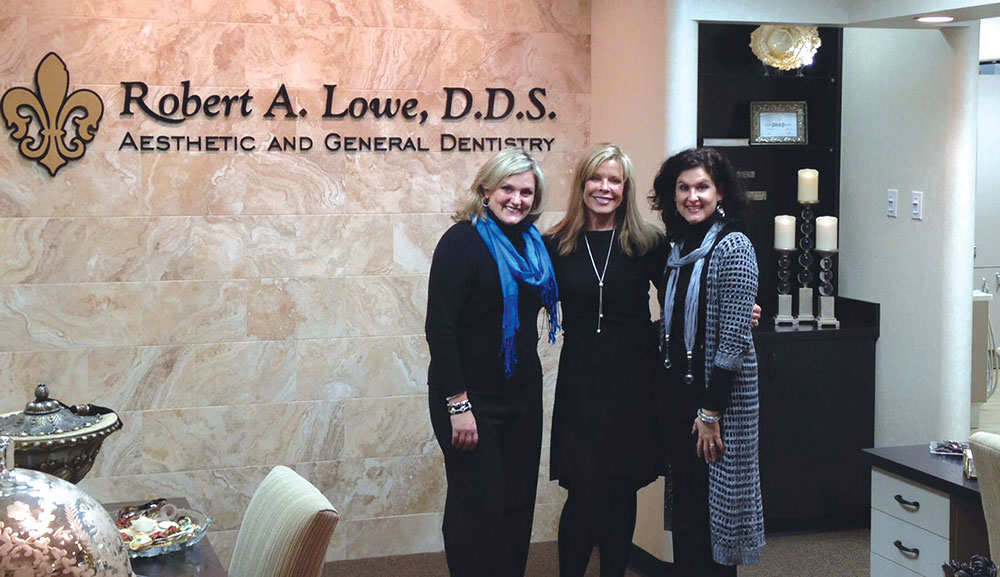
MD: Good to hear. And yes, not only did we set up this interview without talking about the questions ahead of time, unfortunately I don’t think we’ve spoken to each other in the last two years. It’s been a while since we’ve had any lengthy conversation. One of the things that we’re covering in the next issue of the CR newsletter that’s coming out is Class II bulk-fill composites. We see a ton of advertising around this, and the focus of what we’re actually looking at is the role of dual-cure resins. So something like HyperFIL™ by Parkell (Edgewood, N.Y.). Surprisingly, the last time we did depth of cure at CR, we actually got SonicFill™ (Kerr Corporation; Orange, Calif.) to cure 9 mm deep. Of course, that’s in an ideal situation without any cusp tips and the light right on top of it. So that was the king in terms of depth for light-curing, whether it was a high intensity light or a medium. But certainly if you have a dual-cure, you don’t have to worry about depth of cure because it’s dual-cure. So I’m interested to hear your feelings on bulk-filled Class II composites and about your preferences.
RL: I tell you. That’s another one of my favorite topics: Simplifying the placement of Class II composites. Because from a practice management standpoint and a pure remuneration standpoint from the amount of time and effort that it takes to place a well done composite, it’s very stressful. I used to have a full head of hair, and I notice yours is totally gone. I’m working toward your direction as well because we don’t get paid enough to place a good composite. We long for the day where we can have a tooth-colored material that we can throw in like amalgam and there’s no worry with spit or isolation or blood or anything. We pack it and condense it, we carve it and let it set and we’re done.
Too many dentists treat composite like amalgam. Number one, composite is not condensable. It’s like pushing mashed potatoes around in a prep. You can’t make a contact with a Tofflemire and wedge like you could with amalgam. You need a sectional band to push the teeth apart, a contoured sectional matrix and some type of hand instrument to push the matrix and create the additional stress on the side of the band to hopefully get a contact. And even then, it’s difficult. I’ve been a big fan of bulk-fill. Now, the first bulk-fill replacement for dentin that we’ve all had for a long time is glass ionomer. Really, in the States, we just kind of forgot about glass ionomer for the most part. Go to any country that flies under the Queen’s flag and they’ve been using glass ionomer pretty readily as a dentin replacement with sandwich technique for years. It’s all over the literature.
That being said, bulk-fill flowables have come a long way to helping decrease the number of increments and the chair time without sacrificing the quality. I’ve always been a big fan of putting a flowable down underneath a composite because I always wanted my first layer of composite to intimately contact the adhesive in all areas. I felt that if you put an adhesive in and cured it, and then started pushing the mashed potatoes around in the cavity, there’s always going to be voids. There’s no question. I’ll ask dentists, and they say, “Oh, I never get voids in my composites.” But how do you know? “I check it with the explorer.” Well, yeah, OK. That’s the occlusal surface. “There’s no voids on the X-ray.” Can you always see a fracture on an X-ray? I take a tooth out and section it a few times. There’s always voids and layers, and the goal is to decrease the layers to zero if we can. And bulk-filled flowables go a long way, but not all the way. If you talk about a product like SonicFill, and I’ve been a big fan of SonicFill since its inception — I saw it in prototype when I was in roundtables in Europe before it ever came over here — the fact that the sonic energy changes the viscosity such that it adapts well to the cavity, and then once the energy is removed it becomes a sculptable material that is 84% filled by weight, it’s almost like putting amalgam in the hole and carving it. I do not condense a sonic fill restoration. I squirt the stuff in the tooth, I remove the excess off the top like I did with amalgam, I shape it and I cure it.
So, these types of bulk-filled systems are really giving us — as long as you don’t sacrifice the quality, and that’s critical — they’re giving us a way to place composites at least 50% faster with the same excellent result. And for most clinicians that’s huge, because you hate to say it but we’re all in business and time is money. Doing composites and worrying about isolation and all the steps is a lot to deal with. So bulk-filled is here to stay, I think. And things will only get better in all areas.
MD: You mentioned a sectional matrix. I’m sure if we don’t bring it up, a dentist will write in and ask. Which one do you prefer for your Class II technique?
RL: Are people going to be reading this? Or can I just tell you? Is this between you and me? I’ve used Garrison Dental Solutions’ (Spring Lake, Mich.) sectionals for a long time. The Composi-Tight® 3D and the Composi-Tight® 3D XR are great matrices. The Triodent V3 and now V4 as well — actually, the Palodent® Plus from DENTSPLY (Milford, Del.) is actually the Triodent V3. I have both systems. I don’t find one system fits all clinical situations. I find the matrix that fits the best. Like I said, I have fun with the manufacturer all the time. I’ll say, “Eh, sometimes it’s really the Triodent matrix with the Garrison ring that does the trick.”
MD: I’m sure that makes them happy.
RL: Oh, yeah. We’re always as dentists looking for the one magic bullet. And you know what, it depends on many things: How far are the teeth spaced apart? How far do you have to lean the band over? Are the teeth buccally or lingually placed? Some of the sectional matrices are longer and they extend around to the buccal that’ll help you replace part of a cusp or do a larger proximal box, and some of them aren’t. In clinical reality, just like with composite systems, it’s good to have a couple of systems that you can go to and figure out which will work best for that patient in your chair that day.
MD: If you look back at the early days, when I got out of school in 1988, we were trying to do posterior composites with wooden wedges and Tofflemires. It was a beast, and it’s fantastic to be able to use those sectional matrices. Nothing makes me happier than struggling to get that matrix out from in between those teeth.
RL: You need a pair of hemostats to get it out when it’s placed well. The other thing, too, is a lot of dentists struggle getting the matrix in; I’ve always been a big fan of taking those mosquito, or needle-thin, diamonds and going up under the contact and vertically breaking that so my matrix just drops in.
MD: Would that be a 392-016 bur?
RL: Either that or a 465-018 double x, y, z.
MD: Stop it, I’m serious. I think it’s a 392-016.
RL: I have no idea. I don’t know how the people at the bur companies keep track of all the numbers, to be honest with you. I just know it looks like a little needle point.
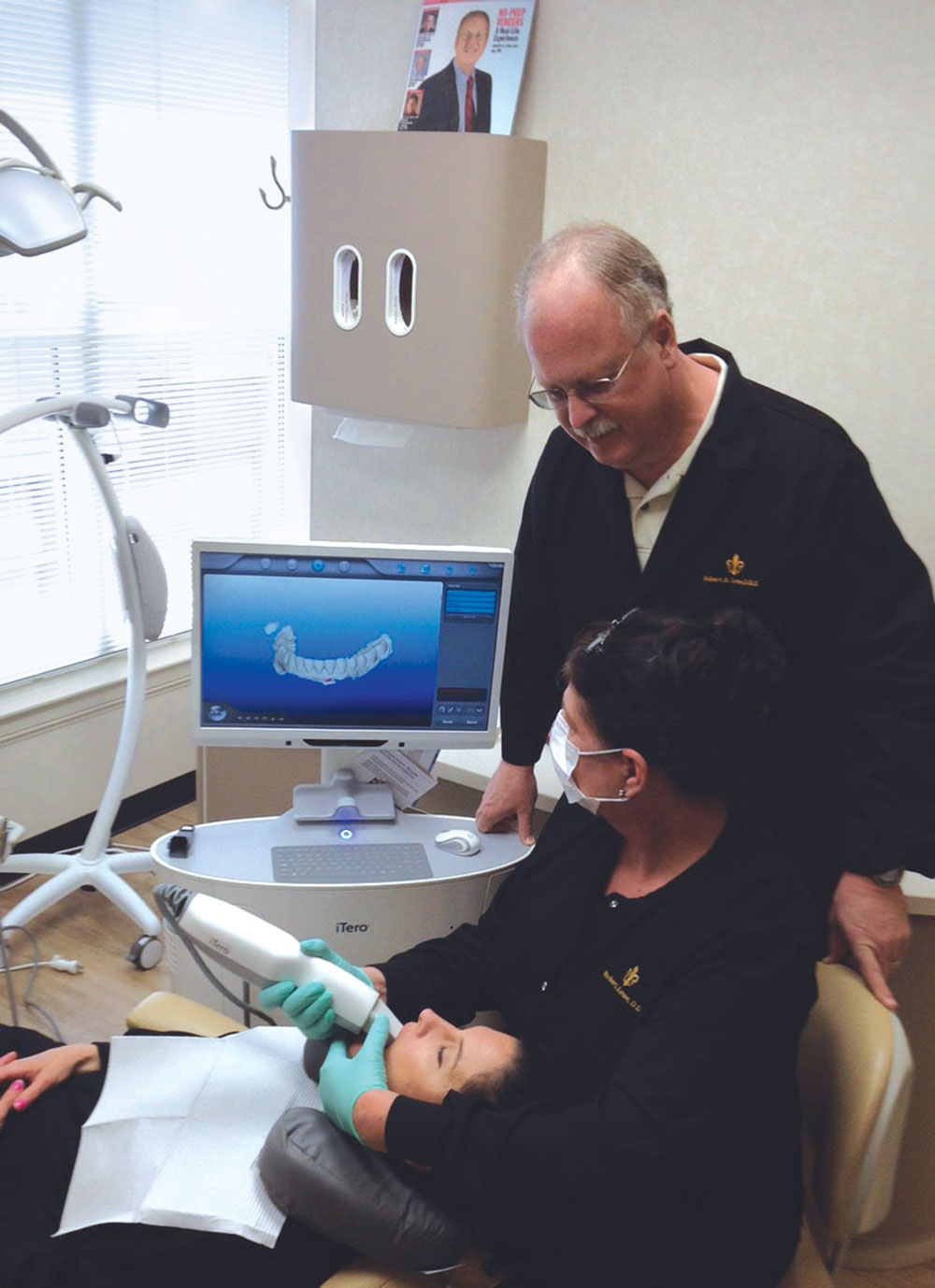
MD: Exactly, it does look like a mosquito tip. I think it’s a 392-016. I get so many questions about burs that I’ve actually had to learn all those different numbers to make sure that I get it right. Well, as we get ready to go, Bob, being named Bob Lowe and being close to being named Rob Lowe, when I told people what I’m doing and tell them who I was interviewing, they got really excited. Have you seen the Rob Lowe commercials for DirecTV?
RL: Oh, sure. In fact, I have one little clip that I found on Facebook that somebody showed me that was a picture of Rob Lowe in a Seahawks outfit and says: “I’m the dumb Rob Lowe. I have the best running back in the world, and I passed the ball from the one.” So you know, it’s pretty funny. The whole Rob Lowe thing follows me around everywhere, including when I did a provisional workshop for a group of dental auxiliaries at Hinman in the ’80s, and the host decided to introduce me with a bit of humor.
MD: Very good. I’m doing one of those hands-on programs for auxiliaries at CDA this year. I really love that; some of the most fun I think you’ll ever have is getting a chance to sit down and do those hands-on programs.
RL: I can’t understand why more states don’t have expanded function. Because you talk about bulk-fill and composites and SonicFill and things like that, and there are some dentists who enjoy working in states that have expanded function. Where the dentist preps the tooth and then the EFDA goes in and places a beautiful restoration. I mean, I’ve done courses with EFDAs as well, and, Docs, a lot of times they do a better job. It’s just one of those things. As I’ve gotten older, I also have learned that there are other people who can do it as good as me. When we all get out of school, there is no one who can do it as good as us. At that time, we don’t know how to delegate.
MD: Speaking of EFDAs, or expanded function dental assistants, we have a Level 2 program here in California. So my EFDA Level 2, when I’m done preparing a tooth she can place the matrix band, etch, bonding agent, SonicFill, she can take that all the way to finish. She can take permanent crown & bridge impressions without me in the room. She can seat permanent crowns without me in the room. But the craziest one of all, Bob, when I’m done cleaning and shaping a root canal she can obturate it without me in the room.

RL: One of these days you’ll be an orthodontist. Sitting on the outside looking in at the ortho world; they know how to delegate and get the team to work. And they always say, “Well yeah, I spend all the time with the diagnosis and the setups and all that.”
MD: Wow, you have no idea what you just stepped into. I’ve been getting a lot of hate mail from orthodontists for the last issue of the magazine.
RL: I have nothing but respect for orthodontists. Bottom line is, when you do a lot of restorative, when the teeth are in the right spot it is so much easier and better. My hat goes off to them. I don’t mean that in a bad way. I mean it more in an envious way. I wish I could work more like them.
MD: And that’s really what the basis of my comments were, too. They were envious comments with tongue planted firmly in cheek. But when you look at orthodontists, they were the original esthetic dentists. We talk about the esthetic revolution in the ’80s; they were straightening teeth for esthetic reasons in the ’60s.
RL: They were the first esthetic dentists. Period.
MD: And frankly, compared to putting porcelain veneers on that have to be redone every 10 to 15 years, I’d rather my daughter have an orthodontic procedure.
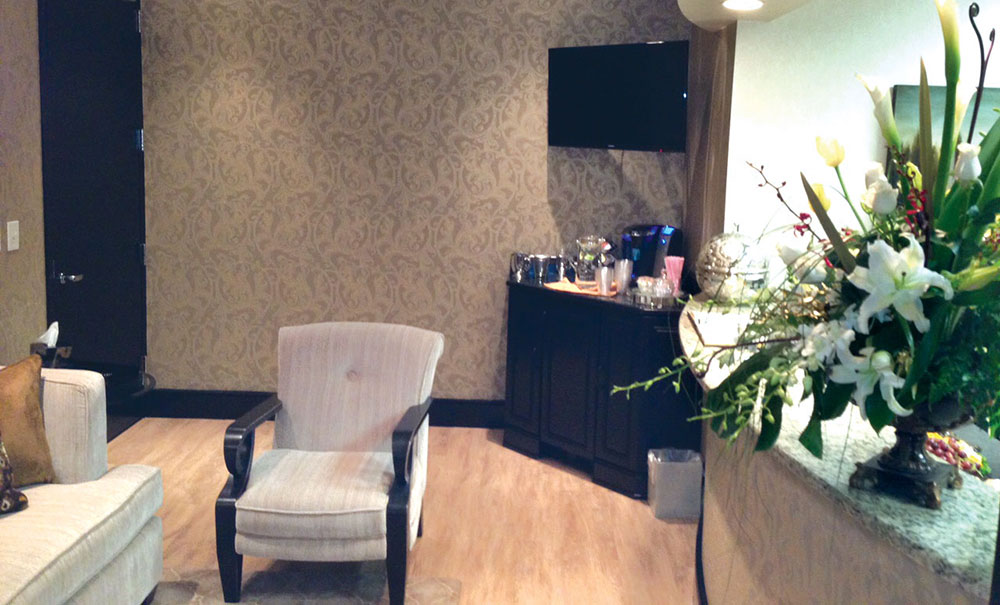
RL: My veneers are 15 years old right now, Michael. I hope they’re not about to break. I hope they don’t have to be redone. It’s funny, people always ask, “Well, how long are they going to last?” And we’ll quote that 10 to 15 years, and they say, “Does that mean at 14 years, 364 days they’re all going to crumble and I’m going to have to have them redone?”
MD: Only if I flip this switch. I have a switch here that’s related to your veneers. And if you miss a cleaning appointment, then yes, they will in fact fail.
RL: That’s right. And IMF will disavow all knowledge of your action.
MD: Well, Bob, it was a pleasure getting a chance to speak to you again. It’s been too long since we’ve run into each other and had a chance to sit down and do this. I’m really glad you were able to sit down and carve out some time for us. I know that our readers will be very happy that you and I got a chance to spend some time together.
RL: Oh, I’m glad. I tell you, anytime, Mike. It’s always been a pleasure working with you and Glidewell Laboratories and Chairside® magazine. I mean, we go back a long ways as far as articles. In fact, I probably owe you another one. I’ll look for one for you. You do a great job right down to the paper to the way the articles are laid out. It’s top-notch. It’s always been a pleasure, and all you need to do is pick up the phone.
MD: We have a great team here, and we always love having your articles in here. I will definitely take you up on that.
Dr. Robert Lowe maintains a private practice in Charlotte, North Carolina. He lectures internationally and publishes in well-known dental journals on esthetic and restorative dentistry. Contact him at boblowedds@aol.com.

